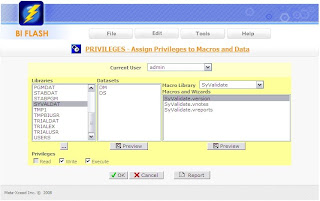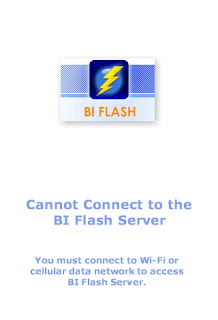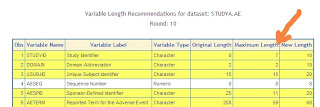Attended scholarship ceremony in Saigon, 90 scholarship, 6 schools, many performances http://bit.ly/4AFRJr
Posts
Showing posts from 2009
Is the Pace of Web Technology Pass me Up?
- Get link
- Other Apps
The pace of innovation got even faster with what I refer to as Web 3.0. Back in the 90's when Web 2.0 was being established, there was a gold rush for websites. Every company including their cousins and grandma it seems was creating their own websites. The website became the new identity complementing the the physical address. It became so ubiquitous that if your organization does not have a website, it does not exist. The majority of sites started out as HTML based sites describing products and services. As web 2.0 evolved, the user's experience became more interactive. Companies such as Google, Salesforce.com and Amazon.com utilized the interactive functionality to make the web experience more like running applications on your desktop. I am witnessing an evolutionary shift from Web 2.0 to 3.0 with the advent of iPhone App. It is analogous to the 90's but rather than asking: "is there a website for that?", it has become: "is there an App for that?" As I
CDISC SDTM Suppqual Domain on iPhone
- Get link
- Other Apps
I was working on a project requiring the creation of many SUPPQUAL data which are supplemental qualifiers data domains within the CDISC data model. The majority of this effort is to identify the SUPPQUAL variables and its related identification variables. You would then need to transpose the source data into the vertical structure for this special purpose domain data structure as specified in SDTM . This does not require a rocket scientist, so I have created an interface on the iPhone where you can create this SUPPQUAL data and then get a preview of the resulting dataset . The video I have recorded below will illustrate how this can be done with relatively little effort.
DEFINE.XML Style Sheet on iPhone
- Get link
- Other Apps
"A style does not go out of style as long as it adapts itself to its period. When there is an incompatibility between the style and a certain state of mind, it is never the style that triumphs." Coco Chanel I was working on updating the style sheet of the DEFINE.XML and incorporated this update to the iPhone BI Flash version as well. This means that DEFINE.XML can be generated as before but not it has the option to have the style sheet that contains the colors that was chosen by the CDISC SDS team. This video illustrates how the DEFINE.XML with this style can be generated.
Web 3.0 of SAS Programming
- Get link
- Other Apps

SAS programming has changed and adapted to the fast changing computing environments. When I first started programming SAS years ago, I had used editors such as VI on Unix and TPU on VMS among a myriad of editors the PC. I refer to this form of developing and editing using these editors as version 1.0 of SAS programming. SAS ’s strengths lies in its analytical tools used for exploring and analyzing data. To take advantage of these tools, I then started to use SAS display manger interactively and then Enterprise Guide as a way of developing SAS programs. These tools provided more data exploration capabilities so I am referring to this as version 2.0 of SAS programming. I see that we are about to enter a new era in SAS programming that can be accomplished anywhere with mobile computing which will be known as version 3.0 of SAS programming. In this case, you can be anywhere away from your office yet still having the ability to edit your SAS programs, submit it and review its out
Verifying CDISC Date Values on the Go
- Get link
- Other Apps
I have analyzed data which contain date variables for years and in the past, they were stored as numeric date variables in SAS format. However, more recently, my date variables are stored as characters since it is often stored in ISO format according to CDISC standards. This makes it challenging to verify since I can not easily apply computations upon a character date value. I therefore have been using a macro named "datetest" which perform a series of checks against the date values to see if it is invalid. Things it catches include examples such as the month being 13 or the day is missing. There are times when I needing to look at many datasets and it is useful to perform this verification on the go on an iPhone. I will share with you this approach in applying the date test on an iPhone as shown in this video.
Generating CDISC DEFINE.XML on iPhone
- Get link
- Other Apps
The data definition or DEFINE.XML is a very useful road map to any data transfer and is particularly important in an electronic submission to the FDA. I had worked on a few projects where as we were preparing the DEFFINE .XML, the meta data or attributes of the data was constantly being updated. This can be simple changes like variable labels or more detailed comments describing how a variable is derived. In this case, it is a challenge getting the latest version of the DEFINE.XML to gain a better understand regarding the latest changes. This became the impetus for making the DEFINE.XML available via the iPhone. The Definedoc was originally a SAS macro that only ran on a SAS server. I then adapted this to be executable on an iPhone. This will allow a user on an iPhone to dynamically execute and get the latest DEFINE.XML upon request and viewable on the go. This means that I can get the view of the latest update that my analyst has worked on at any moment even when I am on the road
SAS iPhone App Approved
- Get link
- Other Apps
I just received a confirmation email from Apple's iTunes store where they process iPhone App applications. It gave me the status of "Ready for Sale" which I am interpreting that my application has been approved. There was no "Congratulation" flair but just matter of fact. The information it provided was: Application Name: BI Flash Application Version Number: 1.0 Application SKU: 1234 Application Apple ID:327568191 When I reviewed the AppStore, it was not there. They did mention that they will process the contract and things will not be live until that is complete. After a couple of hours wait, it became live. I then found it on the App Store and installed it as: I had intended to list it under our company name but somehow it has it under "sy Truong". There has been quite a few updates since the binary has been uploaded for approval as well. I will plan to update all fixes and enhancements so hope that will be updated real soon.
SAS Data Attribute Standards with DIFFTEST on iPhone
- Get link
- Other Apps
One of the most common mistakes in creating data in a standard format is not adhering a standard variable attributes. Verifying this by visual inspection can be a challenge since it is easy to define one variable with a particular length or label on one dataset , while a slightly different attribute on another. This difference can be tested by what I refer to as a DIFFTEST . This can be performed as a SAS macro or on an iPhone. So when you are out and about and just have a sudden dire need to check on your data standards. :) I have recorded a video which illustrates how this can be performed on an iPhone.
CDISC Verification on iPhone
- Get link
- Other Apps
CDISC guidelines helps clinical data comply to a standard intended for submission to the FDA so it is important to ensure that you comply with all the guidelines. If you were to review the CDISC guidelines , you will see hundred of pages of rules which your data must comply with. To do this review manually would be time consuming and most likely lead to errors due to not being able to catching the details. The part that I find challenging about reviewing data against CDISC has to do it multiple times as data is being developed. There are times when I need to review the latest update and I am not at my desk. I have found a solution for this when I am out and about, I can review the latest data on my iPhone. This allows me to see how standardize my data is and I see the status of my CDISC effort at any moment even standing in line at Starbucks. :) I capture a YouTube video as to how this is done which you can see below.
Performing Stability Analysis on iPhone
- Get link
- Other Apps
I was finishing up performing an analysis for a client developing a SAS macro to perform stability analysis. There are some good guidelines for this since the FDA has clearly defined how this is done. I found the article on the FDA website entitled " International Conference on Harmonization (ICH) - Guidance for Industry: Q1E Evaluation of Stability Data " to be very useful. Once I was able to get a SAS macro to perform this task, the next challenge is to have this available on an iPhone so the user can access the latest analysis anywhere on their iPhone. Rather than going into a verbose description here, I recorded a video to illustrate this to you. I find that the iPhone which is a multi-touch graphical user interface can be best explained by showing so hope you find this video useful.
Does some one at Apple review every App sent to AppStore?
- Get link
- Other Apps

I recently submitted an iPhone application to the apple developer program to be approved. This was my first time so the hoops that Apple had me jump through were interesting. The initial application had general information which seems pretty normal. These included things such as: Application Name: BI Flash Application Description: BI Flash delivers business intelligence to information to the iPhone. It takes SAS macros, programs or data on a server and delivers this to iPhone. The user can register the programs or SAS libraries, and then make this available to specified users who can then view this through BI Flash on the iPhone. This is executed in real time so the user gets always the latest data. Primary Category: Business Keywords: Business Intelligence, SAS, Analytics Application URL: http://meta-x.com/biflash These seem pretty standard since they would probably use this for the AppStore. The next step is pretty interesting since it asked for me to check three categories i
Validating Transformation to CDISC SDTM and ADaM
- Get link
- Other Apps
You have just finished transforming your data from your operational clinical database into SDTM and ADaM, now how do you go about validating this? In general you want to have a method that reviews both the structure according to the guidelines and the values of the data to ensure that nothing is changed from what was collected. The following steps uses SAS tools to validate and ensure the integrity of your final CDISC data. Transformation Model Validation- A transformation model documenting the source data and how it was transformed confirming the destination and source variables. Data Value Subset Review - An automated report printing out a subset of the data before and after the transformation is reviewed and validated. This may catch truncation. Categorical Aggregate Review - An automated summary report is generated summarizing the frequency counts of categorical variables verifying the counts are the same. This catches missi
Video Interviews at WUSS 09 Conference
- Get link
- Other Apps
New media has made it possible for a non professional like me to become a reporter. I did an experiment at a recent conference in San Jose. I took my Canon Elph which is normally used for taking pictures and switch on its video mode. It is so small that members that I interviewed barely noticed it was there. I then talked to the attendees at the conference in their area of expertise similar to what I use to do in the traditional blogging days where I would write up the blog based on the interview. The difference this time is upon completion of the interview, I would upload the videos directly to YouTube and whoa.. la... there it was. I did not edit it or do anything. I realize that while holding the camera on my hand, it was not on a tripod so it was perhaps not stable and I was looking at the person I was talking to so the composition was not optimal but this adds to the whole amateur video blogging experience. This experiment of one man on the fly reporting was interesting. I
My SAS Macro Ran with ERRORs on iPhone. The Beauty of SAS Log
- Get link
- Other Apps
SAS macros are script files that execute SAS instructions similar to other SAS programs. It is commonly used to automate tasks since the macros can perform repeated tasks with parameters that can be selected by the user. On the iPhone, this can appear as a list screen with selection choices so the macro can be performed on the server from the selected values on the iPhone. The SAS programmer that loads the macro on the server will configure the macros with different type of parameter selection type including the following examples: On Off Selector These are similar to check boxes where it can be set to on (checked) or off (unchecked). Short Text and Passwords The single text entry allows users to enter any text value to the entry. A similar entry type is the password which will mask the entry so that the text is hidden. Check List This include a check list where the user can select one value from a list of valid values. Tex
How do you view SAS datasets on an iPhone? You chunk it.
- Get link
- Other Apps
Data Overview SAS datasets are stored in libraries on the server similar to how files are stored in folders. Each library is associated with a different folder on the server which contains one or more datasets . You then have the option of selecting the library which contains datasets you wish to view. The screen that lists the available datasets can be accessed through the " Dataset " navigational button at the bottom of your screen. This will list all the available SAS dataset from the specified library. You can then view the contents of the data by selecting on dataset from the list. This is accomplished by tapping anywhere on the row of the displayed dataset name. Selecting Data The main dataset screen displays all datasets that you have access to in the specified library. The list displays a short dataset name followed by the more descriptive dataset label below each dataset . You can select a different library by selecting the library name at the top of the
Most Overlooked Variable Length Error for SAS CDISC Data
- Get link
- Other Apps

The FDA review of an electronic submission requires the merging of submitted data to confirm that the source produces the same aggregate results of the submitted summary analysis. This can only be accomplished if there are clearly defined keys between the datasets and that the keys have standard attributes. A common error that would occur is that the length of the key fields is slightly different. For example, the study identifier (STUDYID) of one set of data is set to length of 7 and another is set to 10. When the two sets are merged, some of the variable values will be truncated leading to errors. An evaluation if key field lengths are crucial in standardizing the key field lengths. CDISC standards are very helpful in getting the variable attributes such as names and labels standardized. It however, does not enforce the standards of lengths leaving it up to you to evaluate and come up with the correct length for each study submitted. The following steps are recommended to standard yo